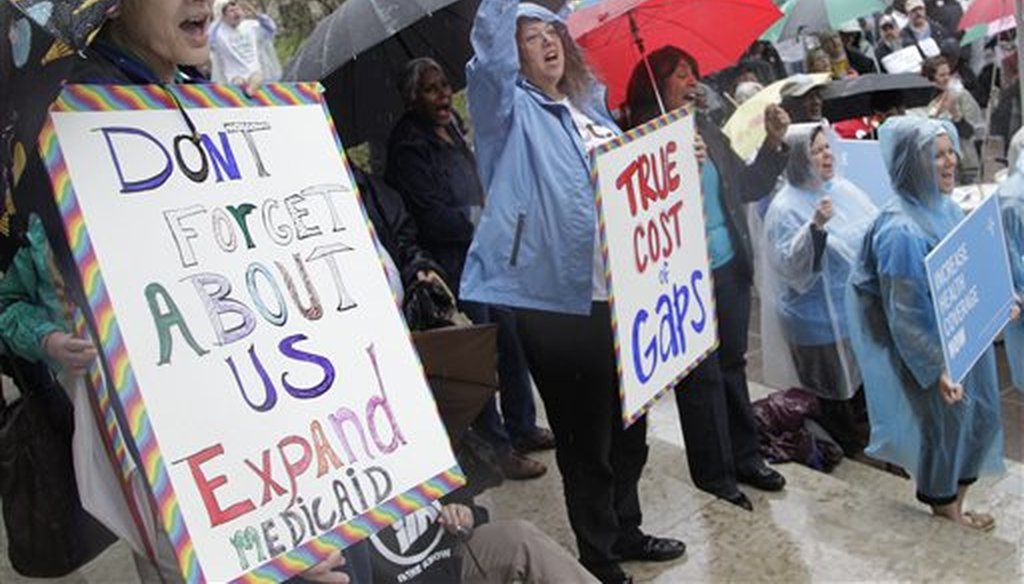

Our only agenda is to publish the truth so you can be an informed participant in democracy.
We need your help.


Demonstrators support for Medicaid extension outside the Ohio Statehouse during a rally on Thursday, April 11, 2013, in Columbus, Ohio. (AP/Jay LaPrete)
If the state expanded Medicaid in 2014, it could have saved $530 million in the 2021-23 budget.
That money could be used to hire more than 3,200 teachers.
However school districts decide for themselves what to do with the aid from the state.
How many teachers could a half a billion dollars pay for using savings from Wisconsin expanding Medicaid? That’s the hypothetical that was raised by state Sen. Chris Larson, D-Milwaukee.
On X, Larson said Wisconsin is one of 10 states that have not expanded Medicaid but if it had done so, the state would have saved $530 million in the 2021-23 budget cycle.
Then he said: "For that amount, we could have hired 3,287 additional K-12 teachers at the statewide median salary, including benefits.That's an average of 7.8 more educators PER DISTRICT."
That seems like a lot of teachers.
We asked Larson’s office for evidence to support his claim and staffers sent us a January 2023 memo from the Legislative Fiscal Bureau that showed the state would have saved $530 million in the 2021-23 budget if Medicaid had been expanded in 2014.
The Republican-controlled Legislature and previous Gov. Scott Walker, a fellow Republican, have been opposed to expanding Medicaid which would provide the state more federal funding.
Medicaid expansion covers the vast majority of the costs of expansion coverage, while generating offsetting savings and, for some states, revenue increases, according to the Center on Budget and Policy Priorities, a nonpartisan research and policy institute.
So, he’s right on that point. But what about the number of teachers?
Lason’s office said it used the median district average salary and fringe benefits from the Wisconsin Department of Public Instruction dashboard for 2022-23.
We went to the department’s dashboard and found the same numbers as Larson. The median average salary is $56,364 and the median average fringe benefits is $24,244. That makes the average teacher compensation including benefits $80,608.
From here it’s simple math. You take the $530 million, divided by the total compensation $80,608 and then divide that number by 2 for the two years the budget covers and it equals roughly 3,287 teachers.
You divide that by 421, the number of school districts in the state, and you get 7.8, which is the potential number of teachers that could be hired per district using the potential savings.
Meanwhile, Bob Lang, executive director of the Legislative Fiscal Bureau said, "using the information that (Larson) received from this office and the Department of Public Instruction, his calculations are correct."
So, Larson’s math is solid. But there are some wrinkles as to how it is applied.
First, even if the Legislature had agreed to the Medicaid expansion, there’s no guarantee the money would have gone toward education – though, of course, Larson was creating his own hypothetical comparison.
DPI spokesperson Chris Bucher noted that Larson was making a "theoretical statement."
"Generally, though, school districts receive aid from the state through a relatively complex formula based on enrollment information," Bucher said in an email. "School districts are also limited in the amount of revenue they can raise by revenue limits. At the end of the day, though, Wisconsin is a local-control state and therefore it is up to individual school districts and school boards to determine budgeting and how much money goes toward hiring personnel and other areas."
Larson said if the state expanded Medicaid, it could save the state $530 million, resulting in more than 3,200 teachers being hired, meaning about seven to eight teachers could be added to each school district.
Although his math is correct, funding from the state is complex and the school districts decide for themselves on how they want to spend the money.
We rate the claim True.
State Sen. Chris Larson tweet, https://twitter.com/SenChrisLarson/status/1722667282155905261, Nov. 9, 2023
Wisconsin Legislative Fiscal Bureau memo on Medicaid expansion, Jan. 9, 2023
Wisconsin Department of Public Instruction, 2021 Educator Preparation Program and Workforce Analysis Report, January 2023
Center of Budget Priorities and Policy, Medicaid expansion FAQ, June 16, 2021
2021-22 Wisconsin Blue Book: Public education in Wisconsin, last checked February 2024.
In a world of wild talk and fake news, help us stand up for the facts.
